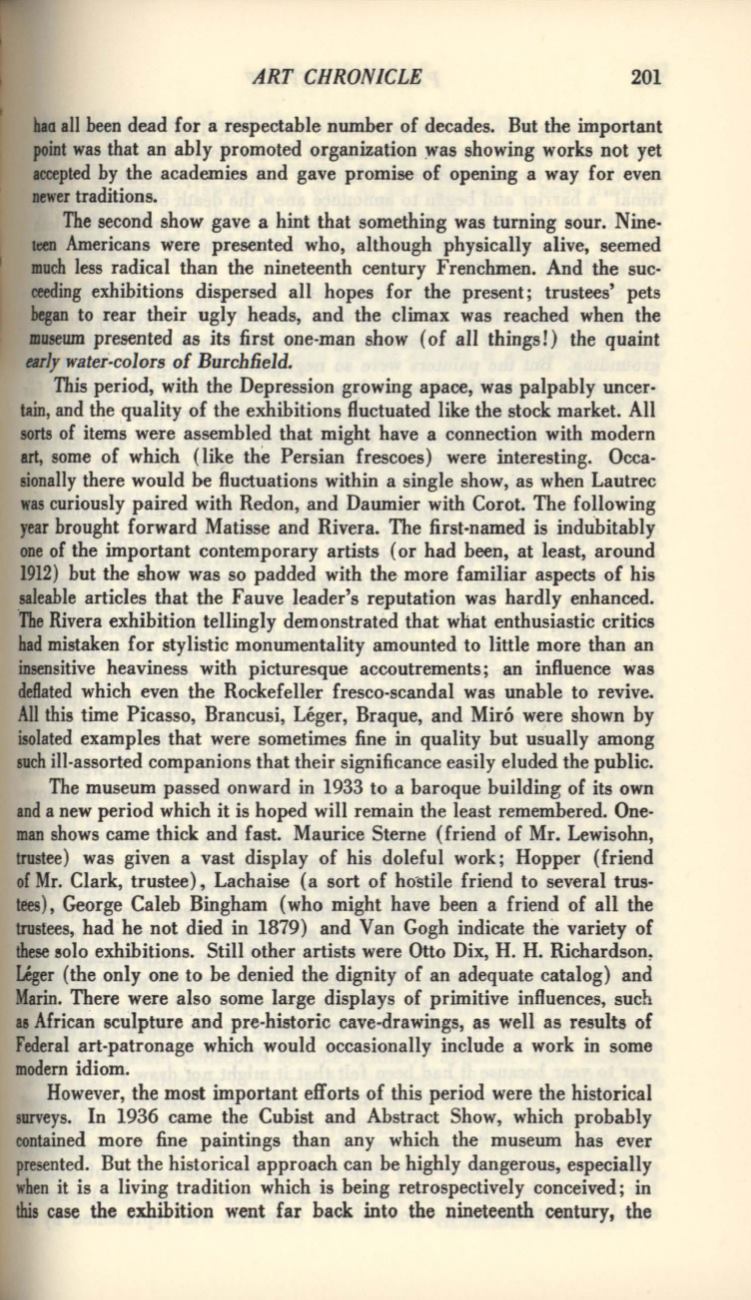
ART CHRONICLE
201
baa all been dead for a respectable number of decades. But the important
point was that an ably promoted organization :was showing works not yet
accepted by the academies and gave promise of opening a way for even
Dewer traditions.
The second show gave a hint that something was turning sour. Nine·
\eeD
Americans were presented who, although physically alive, seemed
much less radical than the nineteenth century Frenchmen. And the suc·
ceeding exhibitions dispersed all hopes for the present; trustees' pets
began to rear their ugly heads, and the climax was reached when the
museum presented as its first one·man show (of all things!) the quaint
eMIr
water·colors of Burchfield.
This period, with the Depression growing apace, was palpably uncer·
tain, and the quality of the exhibitions fluctuated like the stock market. All
sorts of items were assembled that might have a connection with modern
art,
some of which (like the Persian frescoes) were interesting. Occa·
sionally there would be fluctuations within a single show, as when Lautrec
was curiously paired with Redon, and Daumier with Corot. The following
year brought forward Matisse and Rivera. The first·named is indubitably
one of the important contemporary artists (or had been, at least, around
1912) but the show was so padded with the more familiar aspects of his
saleable articles that the Fauve leader's reputation was hardly enhanced.
The
Rivera exhibition tellingly demonstrated that what enthusiastic critics
bad mistaken for stylistic monumentality amounted to little more than an
insensitive heaviness with picturesque accoutrements; an influence was
deflated which even the Rockefeller fresco·scandal was unable to revive.
All
this time Picasso, Brancusi, Leger, Braque, and Miro were shown by
isolated examples that were sometimes fine in quality but usually among
such ill·assorted companions that their significance easily eluded the public.
The museum passed onward in 1933 to a baroque building of its own
and a new period which it is hoped will remain the least remembered. One·
man shows came thick and fast. Maurice Sterne (friend of Mr. Lewisohn,
trustee) was given a vast display of his doleful work; Hopper (friend
of Mr. Clark, trustee), Lachaise (a sort of hO'stile friend to several trus–
tees),
George Caleb Bingham (who might have been a friend of all the
trustees, had he not died in 1879) and Van Gogh indicate the variety of
these
8010
exhibitions. Still other artists were Otto Dix, H. H. Richardson,
Leger (the only one to be denied the dignity of an adequate catalog) and
Marin. There were also some large displays of primitive influences, such
as African sculpture and pre-historic cave-drawings, as well as results of
Federal art-patronage which would occasionally include a work in some
modern idiom.
However, the most important efforts of this period were the historical
surveys. In 1936 came the Cubist and Abstract Show, which probably
contained more fine paintings than any which the museum has ever
presented. But the historical approach can be highly dangerous, especially
when it is a living tradition which is being retrospectively conceived; in
this
case the exhibition went far back into the nineteenth century, the


